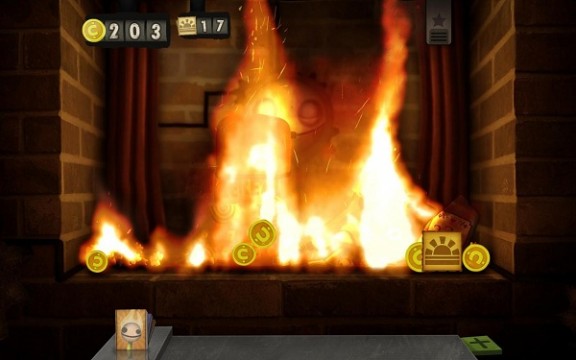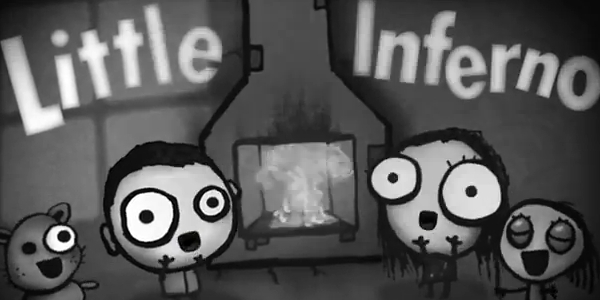Terrific atmosphere; beautiful animation; impeccable pacing; thought provoking
Little gameplay; unsatisfying and ambiguous ending
As a kid, I almost burned down my house when I tried to fix a dented ping pong ball by running it through fire. Years later, I’m burning everything to ashes in one of Wii U’s most intriguing eShop launch titles. Created by the makers of World of Goo and Henry Hatsworth in the Puzzling Adventure, Little Inferno ignores conventions to become a title everyone should experience, even though it’s not technically a game in the traditional sense.
You play as a wonky kid with a new toy: the Little Inferno Entertainment Fireplace. To play with this toy, you throw things in it and set them on fire to earn coins to buy more things to set on fire. The fire is to keep you warm, because it has been snowing for as long as anyone can remember.
That’s it. That’s the entire fifteen dollar, three-hour package. There is little to no gameplay here. You spend the majority of your time staring at your fireplace, be that on your Wii U GamePad or your TV. You spend the rest of your time browsing the catalog for purchasable toys and miscellaneous objects to set on fire with your Wii U GamePad touchscreen or your Wii remote.
The control here is intuitive and crisp and setting things on fire has never been as easy or satisfying. By burning your toys to collect coins, you can purchase and unlock more toys from the catalog. By burning different combination of toys simultaneously, you can unlock combos in the catalog hinted at by their cryptic names. Unlocking combos unlocks more catalogs, which contain more unlockable toys, and so on. That’s the core gameplay in Little Inferno, but there’s much more to this game than meets the eye.

Fire is beautiful…
Little Inferno is a creepy movie. Fans of World of Goo will immediately recognize the moody and impish art direction, and each toy shines with character, reacting in hilarious and impressive ways when you toss them into the fireplace. When you set them on fire… man, they’re beautiful. Let’s just say you will want to set them on fire again. Cheeky sound effects also accompany the eye-catching visuals and memorable, polished music adds class and intimacy, creating an absolutely stunning atmosphere.
It’s also a novel. Amidst all the ashes, you receive letters from your strange friends Sugar Plum, Miss Nancy, and the Weather Man. Reading the letters teaches you about the frosty world you live in and reveals that Little Inferno is a satire on life, hope, the future, and most of all, games. Burning toys in the fireplace for hours on end quickly leads you to question the point of it all. Why do you keep buying toys to burn them?
It’s because Little Inferno is also, at its heart, a game. As the game goes on, purchased goods take up to several minutes to be “delivered” to you. You can speed up the delivery with tickets earned by unlocking combos. This delivery mechanic creates an impeccable pacing that lies at the heart of Little Inferno as a game and as satire.

As a game, it begins innocently, letting you burn wooden blocks and stuffed animals within seconds. You begin to understand the delivery mechanic several minutes later, and by then, you’re burning live fish and creepy spiders. The pacing created by the delivery mechanic drives your progress to unlock more catalogs, more toys, and more combos. Soon, you’re burning not only toys, but books, the Sun, and a Handheld Fireplace that looks like a Game & Watch. You’re burning knowledge, the future, and the very games you played as a child, and you do it all because of the pull of the mysterious story.
As you burn more toys, you get more letters and the more you learn about the world outside. So you keep setting your toys on fire, but at some point, you realize that the faster you burn your toys, the sooner the story will end– and the sooner you will have to stop burning your toys. Then, you realize that you want to keep burning your toys because the delivery mechanic is psychological black magic. In Little Inferno, you face an absurdly intriguing conflict between playing the game and continuing the story. At some point, you realize that you cannot do both, and the satire here is the conversation between you and your pen pals, between the fireplace and the world, and between the delivery mechanic and the story of the game.
People burn symbols like flags and books to demonstrate dissent, but what does it mean to burn a Handheld Fireplace in a Little Inferno Entertainment Fireplace? Spare an afternoon and fifteen dollars and you might find out. You can treat Little Inferno like a bedtime story or a three-hour movie, but remember that at its heart, Little Inferno is a game about games. It will make you think about what you do in games, the purpose of games, and the future of games, so sit tight, think hard, and keep burning those toys.
Nintendojo was provided a copy of this game for review by a third party, though that does not affect our recommendation. For every review, Nintendojo uses a standard criteria.




 ShareThis
ShareThis







This is the best-written review of Little Inferno I’ve come across. I’m actually intrigued to try it now, where other reviewers left me as confused as they apparently were themselves.
Kudos for bothering to understand the thing you’re reviewing! Apparently that’s a bit rare. :^)
Thanks! Games like this deserve the attention!
This game is really great!